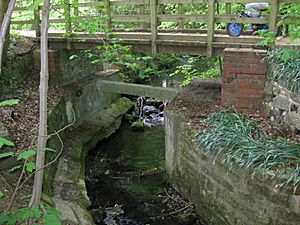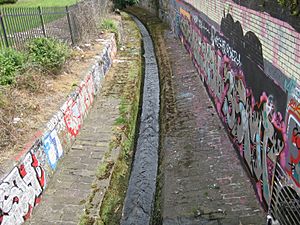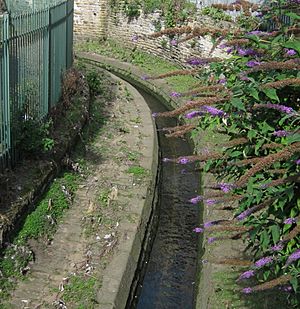Meanwood Beck facts for kids
The Meanwood Beck is a small river, also called a stream, in West Yorkshire, England. It flows south through areas like Adel, Meanwood, and Sheepscar. Eventually, it joins the River Aire in the middle of Leeds.
This same stream has been known by many names along its path. These include Adel Beck, Carr Beck, Lady Beck, Mabgate Beck, Sheepscar Beck, Timble Beck, or Wortley Beck. A popular walking path, the Meanwood Valley Trail, follows the beck for most of its journey.
Contents
Where Does Meanwood Beck Start?
The water for Meanwood Beck originally comes from Otley Chevin, a hill nearby. A smaller stream called Marsh Beck flows into what is now the Wildfowl Lake in Golden Acre Park.
After leaving this lake, the stream is called Adel Beck. It keeps this name until it reaches the A6120 Ring Road. After that, it becomes known as the Meanwood Beck.
In the past, maps showed different names for parts of the beck. For example, a 1775 map of Leeds by John Cossins showed Sheepscar Beck as the eastern edge of the town. Further downstream, from Quarry Hill to the River Aire, it was called the Lady Beck.
Meanwood Beck's Role in Leeds History
The Meanwood Beck played a very important part in the early days of Leeds. It carried silt and mud, depositing them into the River Aire. Another nearby stream, the Hol Beck, did the same from the southwest.
These deposits created a shallow place where people could cross the river, known as a fording place. A small community grew around this crossing point, which eventually became the large city of Leeds we know today.
The beck also provided water for the village of Headingley long ago. Two of its earliest bridges were built to give direct access to the beck. Today, the beck carries much less water because many modern drains in the city collect water instead.
Meanwood Beck and Local Parks
The Meanwood Beck flows through several green spaces in Leeds. You can find it running through Meanwood Park and Woodhouse Ridge. It also provides water and drainage for the Meanwood Valley Urban Farm, which is a community farm.
Meanwood Beck's Industrial Past
For hundreds of years, the Meanwood Beck was a source of power for local industries.
Powering Mills and Factories
- 16th to 18th Centuries: The beck's flowing water was used to power corn mills. These mills ground grain into flour.
- 19th Century: Later, the beck supplied water for other industries. These included chemical works and tanneries, which processed animal hides into leather. One of these old tanneries, called Sugarwell Court, has now been turned into a university hall of residence for students.
Wildlife and Environmental Concerns
The Meanwood Beck is home to various types of wildlife, but it has faced challenges.
Native Crayfish and Threats
The beck is a habitat for the native European crayfish. This type of crayfish is currently at risk in the UK. The main threat comes from a disease carried by the Signal crayfish, which was brought over from America.
Other Aquatic Life
Besides crayfish, you can also find bullhead fish in the beck. These small fish usually live on the stream bed, hidden in the mud and silt.
Pollution Incident
On March 29, 1999, the beck suffered a serious pollution event. An oil tank at the University of Leeds' Bodington Hall was accidentally overfilled. About 10,000 litres of oil flowed into the Meanwood Beck, causing harm to its environment.






